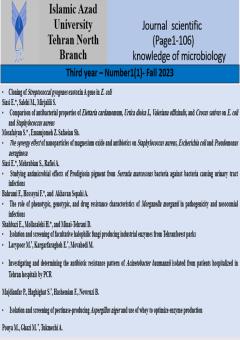Investigating and determining the antibiotic resistance pattern of Acinetobacter baumannii isolated from patients hospitalized in Tehran hospitals by PCR
Subject Areas : Microbiologyparisa Majdianfar 1 , ستاره حقیقت 2 , farshad hashemian 3 , Bahareh Nowruzi 4
1 - Department of Microbiology, Faculty of Advanced Science and Technology, Tehran Medical Sciences, Islamic Azad University, Tehran, Iran
2 - عضو هیئت علمی دانشگاه آزاد اسلامی واحد تهران پزشکی-دانشکده فناوری های نوین-گروه میکروب شناسی
3 - department of clinical pharmacy, IAUPS, tehran, Iran
4 - Department of Biotechnology, Faculty of Converging Sciences and Technologies, Islamic Azad University, Science and Research Branch, Tehran, Iran
Keywords: Acinetobacter baumannii, Antibiotic resistance, Antibiogram, PCR,
Abstract :
Abstract Aim and Background: Acinetobacter baumannii is an opportunistic bacterial pathogen responsible for a wide range of hospital-acquired infections. These bacteria take a variety of factors for resistance to different antibiotics, including resistance to β-lactams, aminoglycosides, and tetracyclines. The aims of this study were to determine the antimicrobial susceptibility pattern and prevalence of bla IMP4, bla CTX-M, tetA, and aadB genes in A. baumannii strains obtained from Imam Khomeini, Bahman, Bu-Ali, and Momenin hospitals. Material and Methods: In this cross-sectional study, 100 clinical Acinetobacter baumannii isolates were collected from various hospitals in Tehran. After the identification of Acinetobacter baumannii isolates by biochemical tests, the antibiotic susceptibility test (Kirby-Bauer method) was done according to CLSI 2021 advice against 8 antibiotics. Finally, the bla IMP4, bla CTX-M, tetA, and aadB genes were determined among the antibiotic-resistant isolates using PCR. Results: According to results, the disc diffusion results showed resistance rates of 90% for ciprofloxacin, 32% ceftazidime, 25% imipenem, 36% gentamicin, 34% streptomycin, 28% piperacillin, 5% polymyxin B and 63% tetracyclin. All isolates were susceptible to colistin. PCR results for bla IMP4, bla CTX-M, tetA, and aadB genes were detected in 63%, 62%, 76%, and 71% of resistant isolates respectively. Conclusion: This study detected clinical A. baumannii isolates harboring antibiotic resistance genes. Identification of antibiotic resistance patterns in A. baumannii and investigation of molecular epidemiology is critical to controlling the rapid spread of antimicrobial-resistant strains
1. Nguyen M, Joshi S. Carbapenem resistance in Acinetobacter baumannii, and their importance in hospital‐acquired infections: a scientific review. Journal of applied microbiology. 2021;131(6):2715-38.
2. López M, Blasco L, Gato E, Perez A, Fernández-Garcia L, Martínez-Martinez L, et al. Response to bile salts in clinical strains of Acinetobacter baumannii lacking the AdeABC efflux pump: virulence associated with quorum sensing. Frontiers in cellular and infection microbiology. 2017;7:143.
3. Wong D, Nielsen TB, Bonomo RA, Pantapalangkoor P, Luna B, Spellberg B. Clinical and pathophysiological overview of Acinetobacter infections: a century of challenges. Clinical microbiology reviews. 2017;30(1):409-47.
4. Viehman JA, Nguyen MH. Treatment options for carbapenem-resistant and extensively drug-resistant Acinetobacter baumannii infections. Drugs. 2014;74(12):1315-33.
5. Poirel L, Bonnin RA, Nordmann P. Genetic basis of antibiotic resistance in pathogenic Acinetobacter species. IUBMB life. 2011;63(12):1061-7.
6. Li F-J, Starrs L, Burgio G. Tug of war between Acinetobacter baumannii and host immune responses. Pathogens and disease. 2018;76(9):ftz004.
7. Yusuf I, Skiebe E, Wilharm G. Evaluation of CHROMagar Acinetobacter and MacConkey media for the recovery of Acinetobacter baumannii from soil samples. Letters in Applied Microbiology. 2023;76(2):ovac051.
8. Medioli F, Bacca E, Faltoni M, Burastero GJ, Volpi S, Menozzi M, et al. Is it possible to eradicate carbapenem-resistant Acinetobacter baumannii (CRAB) from endemic hospitals? Antibiotics. 2022;11(8):1015.
9. Chang Y, Luan G, Xu Y, Wang Y, Shen M, Zhang C, et al. Characterization of carbapenem-resistant Acinetobacter baumannii isolates in a Chinese teaching hospital. Frontiers in microbiology. 2015;6:910.
10. Liu Y, Liu X. Detection of AmpC β-lactamases in Acinetobacter baumannii in the Xuzhou region and analysis of drug resistance. Experimental and therapeutic medicine. 2015;10(3):933-6.
11. Aksoy MD, Çavuşlu Ş, Tuğrul HM. Investigation of metallo beta lactamases and oxacilinases in carbapenem resistant Acinetobacter baumannii strains isolated from inpatients. Balkan medical journal. 2015;32(1):79-83.
12. Shoja S, Moosavian M, Rostami S, Abbasi F, Tabatabaiefar MA, Peymani A. Characterization of oxacillinase and metallo-β-lactamas genes and molecular typing of clinical isolates of Acinetobacter baumannii in Ahvaz, South-West of Iran. Jundishapur journal of microbiology. 2016;9(5).
13. Khosroshahi SA, Farajnia S, Azhari F, Hosseini MK, Khanipour F, Farajnia H, et al. Antimicrobial Susceptibility Pattern and Prevalence of Extended-Spectrum β-Lactamase Genotypes among Clinical Isolates of Acinetobacter baumanii in Tabriz, North-West of Iran. Jundishapur Journal of Microbiology. 2017;10(6).
14. Hashemizadeh Z, Emami A, Rahimi M. Acinetobacter antibiotic resistance and frequency of ESBL-producing strains in ICU patients of Namazi Hospital (2008-2009). Journal of Inflammatory Diseases. 2010;14(2):47-53.
15. Peymani A, Nahaei M-R, Farajnia S, Hasani A, Mirsalehian A, Sohrabi N, et al. High prevalence of metallo-β-lactamase-producing Acinetobacter baumannii in a teaching hospital in Tabriz, Iran. Japanese journal of infectious diseases. 2011;64(1):69-71.
16. Sharif M. Molecular identification of TEM and SHV extended spectrum beta -lactamase in clinical isolates of Acinetobacter baumannii from Tehran hospitals. 2014.


